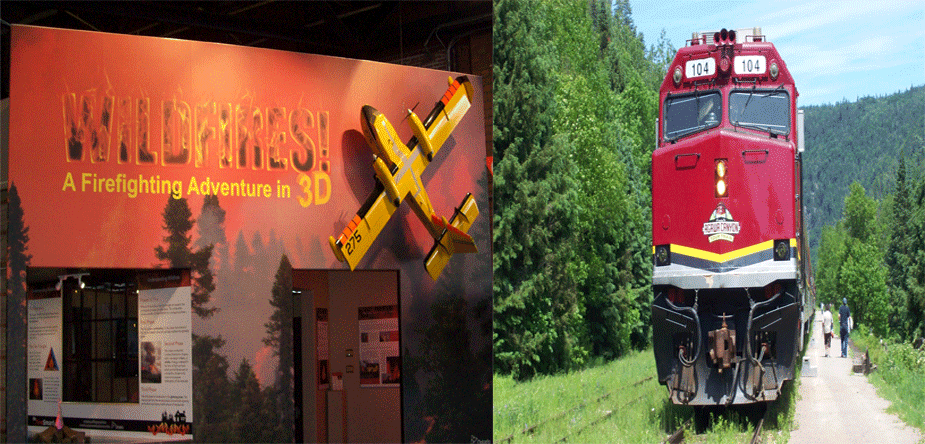 Located right in the heart of the Canadian wilderness Sault Ste. Marie, known as The Soo, is surrounded by water, forests, mountains and lakes. To the south, across the river are the United States and the city of Sault Ste. Marie, Michigan. The two cities are joined by the International Bridge, which connects Interstate 75 on the Michigan side and Huron Street on the Ontario side.
Located right in the heart of the Canadian wilderness Sault Ste. Marie, known as The Soo, is surrounded by water, forests, mountains and lakes. To the south, across the river are the United States and the city of Sault Ste. Marie, Michigan. The two cities are joined by the International Bridge, which connects Interstate 75 on the Michigan side and Huron Street on the Ontario side.
We took a 90-minute Westjet flight from New York to Toronto’s Billy Bishop Airport and then a small Air Canada plane to Sault Ste. Marie. The Quality Inn Bay Front Hotel located in the downtown city center would be our hotel for the next three nights. Our well-furnished room including a bay window gave us a magnificent view of the International Bridge linking Lake Superior to Sault Ste Marie, Ontario and Sault Ste. Marie, Michigan. The Quality Inn Bay Front Hotel ideally located near the Agawa Canyon Tour Train Stationoffered many full-service amenities including free wireless high-speed Internet access and a free breakfast. Guests can also enjoy relaxing in the indoor pool, hot tub, sauna and exercise rooms.
Our morning tour followed the coastline of Lake Superior on Highway 17 with breathtaking views of crystal clear waters to the Lake Superior Provincial Park. Historically, man hunted, canoed and fished this land for survival. Our first stop in the Park was the Agawa Bay Interpretative Center, a state of the art facility highlighting the history and geography of Lake Superior, with a selection of videos, painting, photographs and sculptures.
Continuing in the Park a sign showed us the way to the Agawa Rock Pictographs, the sacred site of ancient paintings of Ojibwe natives. For centuries Ojibwe artists painted spiritual images on the face of the cliffs at Agawa Rock which rises 98 ft above Lake Superior. ereHeWe walked the 400 meter trail to the Pictograph Rock formation watching our steps as the trail got a little rocky with massive split boulders. At the bottom were thirty-five pictographs on the cliffs of Lake Superior. The pictographs allowed us a glimpse into traditional Ojibwe life along this rugged coast.
Afterwards, we followed the Coast Line of Lake Superior and stopped at a Lookout Point where many objects symbolizing “safe travel” were made by Ojibwe natives. On our way back to the city, we visited Bachawana Bay and continued to the Frontiers Village. Entering the Village was like stepping back in time to the beginning of the 19th century. There were multiple towering life-size woodcarvings depicting scenes from the old West as well as animals in a natural setting surrounded by pioneers. This Village also featured a collection of unique shops and restaurants.
Located near Pancake Bay Provincial Park 46 miles north of Sault Ste Marie on Highway 17 were the Agawa Crafts and the Canadian Carver. This unique retail outfit featured woodcarvings and sculptures of more than 250 carvers from across Canada plus a wide variety of gifts, hand-made blankets, quilts, moccasins and other Indian crafts.
Overlooking Batchawana Bay was the Voyager’s Lodge and Cookhouse. Originally a trading post, today it is noted for home-cooked meals. On the menu were fresh whitefish, trout, bison burgers, crispy chicken, salads and garlic buttered bannock bread. Bannock is a Scottish word meaning scone. It was a staple of the First Nations People traditionally made with root flours and natural sweeteners. From the Cookhouse we walked over the bridge along Highway 17 to view Chippewa Falls, the midpoint of the Trans Canada Highway.
On Bay Street in a 1940’s waterfront hanger is the Canadian Bushplane Heritage Centre, a museum dedicated to preserving the history of bush flying and forest protection in Canada. This 64,000 square foot hanger holds over thirty aviation and forestry-themed displays. Our tour guide, Edie Suriano, provided us with an exciting interactive hands-on experience where we were able to take a ride in a flight stimulator choosing three different 4-minute flights, each highlighting a different aspect of northern Ontario. Interesting displays were the Turbo Beaver, Grumman Tracker, deHavilland Otter, Canadair CL-215 and the Bell Helicopter used in the Mash movies. Another hands-on experience was climbing into a Beech 18 cockpit – planes which carried passengers, freight and aerial photo surveyors.
In the Bushplane Heritage Centre is a fire-fighter’s camp where you can climb a 30-foot high fire tower. The Ranger Theatre showed a film Wildfires! A Fire Fighting Adventure in 3-D, which tells the story of how the Aviation Forest Fire Fighters and Emergency Service Branch battle forest fires in the air and on the ground. This Museum also accommodates group visits, motorcoach tours, family reunions and weddings. Children play and learn in a hands-on interactive Children’s Flight Centre where they experience the science of flight and test out a flight simulator to find out what it takes to be a pilot.
The following day our excursion began 8:00am at the Algoma Central Railway depot where we boarded the train for a day-long rail adventure through the wilderness of Northern Ontario. As the train starts a flat screen monitor commentary tells us about the upcoming points of interest and the rich history of this region with stories of the Ojibwe fur traders and explorers that opened up this vast wilderness. It took us on a 228-mile round trip and transported us over towering trestles through the granite rock formation descending into the Canyon. The train began its descent into the Canyon at Mile 102 travelling down 500 feet over 12 miles to the floor of the Agawa Canyon. At Mile 114 the train stops in the Wilderness Park for an hour and half. We decided not to climb the 300 stairs to the lookout platform 250 feet above the Canyon, but took a scenic walk on graveled trails to the viewing platforms of the Bridal Veil Falls and Black Beaver Falls. Our trip back took us to the Algoma Central Railway on Bay Street.
A hot and cold breakfast, plus lunch or picnic box lunch with assorted hot and cold beverages is available in the dining car from time of boarding until 4:00PM. This one-day wilderness Algoma Country excursion departs daily from late June to mid-October.
Dinner was at Giovanni’s Italian Restaurant, serving “The Soo” since 1978. We experienced a touch of Italy with homemade sauces, pastas, steaks, ribs, chicken and seafood. Their Italian bread with butter and a chunk of garlic on the side surrounded by mozzarella cheese was exceptional.
Before leaving for our trip home we made stops at the Ermatinger-Clerque National Historic Site, the Sault Ste. Marie Museum and the Art Gallery of Algoma. The Ermatinger-Clerque National Historic Site was built in1812 by Charles Oakes Ermatinger and became the center of the business and social life. It is the oldest surviving house in Northern Ontario consisting of two stone buildings – the Ermatinger Old Stone House and the Clergue Blockhouse.
In the Old Stone House we gained insight into the pioneer lifestyle in the 19th century with a knowledgeable guide dressed in clothing of that era. On the main floor the Victorian Parlor was a gentlemen’s sitting room along with a Clerk’s office and a tavern. Women were only allowed in the room to serve refreshments or clean-up after the gentlemen. Other interesting rooms were the dining room and a bedroom with a four poster canapé bed. Behind the Main House on Queen Street is the Summer Kitchen – the original kitchen was destroyed in a fire in 1840. A demonstration on making cupcakes showed us how food was churned in the oven. In winter the heat from the crackling fire made this room the warmest in the house.
The Clergue Blockhouse, located to the east of the Ermatinger Old Stone House, depicts the life of Francis Hector Clergue through the use of interpretive panels and interactive displays. Each section of the heritage landscape represented the cultural and historic way of life for the early settlers and First Nation people.
The Sault Ste. Marie Museum, originally the Old Post Office Building, preserves the local heritage of Sault Ste. Marie by photo displays. Interesting exhibits included a pictorial display of early Great Lakes cruise ships with a brief history of the Locks, the history of Francis Hector Clergue and his involvement in the early industrial development of Sault Ste. Marie and a Discovery Gallery for children of all ages.
The Art Gallery of Algoma (AGA) is the only collecting public art gallery located between Thunder Bay and Sudbury, Ontario. It consists of an impressive collection of over 5,000 artworks includes paintings, sculptures, photographs and decorative arts by artists of the City of Sault Ste. Marie and surrounding area. This Art Gallery is surrounded by a beautiful Sculpture Garden on the banks of the St. Mary’s River. Jasmina Jovanovic, Director of AGA, introduced us to an exquisite exhibition by renowned contemporary Inuit sculptor, Abraham Anghik Ruben. The exhibition entitled “Arctic Journeys Ancient Memories” gave us a rare opportunity to view 20 carved sculptures in bone, stone, ivory and bronze.
A Partnership of Four of Sault Ste. Marie Favorite Attractions provides admission to four sites for one low price and saves approximately one-half of admission fees. There is no expiration date and can be used at any time between May and November:
Sault Ste. Marie Museum
Art Gallery of Algoma
Ermatinger • Clergue National Historic Site
Canadian Bushplane Heritage Centre
For more information visit: http://www.saulttourism.com


